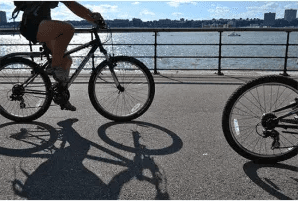As people attempt to get in shape and save money on fuel costs, biking becomes more popular. While we all know about the benefits of riding a bicycle, few people ever discuss the hazards involved. That’s why we feel the importance of addressing bicycle accidents and how to stay safe while on your bike.
We’ve put together our best tips for you, broken down into various categories.
Step One: Checking the Bike
1. Choose the Appropriate Size
Your bike must provide the proper size for your height. If you ride one that’s too small or too big, you face challenges with control and handling.
Bike manufacturers use a sizing charge to indicate the measurements of each bike offered. Initially, it might seem overwhelming to analyze this data, but it’s essential to your safety.
When choosing a bike, you want your feet to sit flat on the ground when you stand over the bike’s top tube. There should also be a couple of inches of space between that top and your groin. If you can, talk to an experienced salesperson for the proper fit of your bike.
2. Inspect Your Bike
Most people aren’t bike mechanics and might feel lost when looking at all the nuts and bolts of your equipment. That’s natural, but you still need to take the time to inspect everything and ensure proper working condition.
Armed with some bike tools, a few things must receive a regular evaluation. First, look at all the bolts of the handlebar, pedals, seat post, stem and quick release on the wheels. If anything looks loose, corroded or in bad shape, it needs replacement.
Then, press your front brakes while pushing the bike back and forth. This action helps you evaluate if the headset is loose. Tighten anything in need of attention and make sure nothing rattles.
3. Pay Close Attention to the Tires
During your inspection, you must pay special attention to the tires. They must be adequately inflated to protect you on the road. Find out what the recommended air pressure is by looking at the tire sidewalls. Then, use your air compressor or manual pump to inflate them as needed.
Don’t exceed the recommended pressure or you could face a blowout. On a hot day, the pressure naturally increases as the tire expands. It’s essential to keep that in mind if you bike on warm days.
If your tires ever appear worn or you find debris sticking out of them, it’s time to consider a replacement. After all, the only part of your bike touching the road is your tires. They are critical to your safety.
4. Inspect the Spokes
Most often, this step won’t result in much, unless you hit many potholes. Take a quick look over the wheels and inspect the spokes. They shouldn’t be bent or loose. Spin your wheels and see if they spin properly. You don’t want to see any wobbling. If you do, it’s time to take it to the bike shop.
5. Check Lights & Bell
It’s recommended that you use a headlight plus a tail light during the day and at night. Front lights help you to see, and they let others know where you are. To stand out more in the daylight hours, you might consider setting the lights to a strobe or flash mode because it draws more attention.
Another critical aspect of having lights is ensuring that the batteries are in good working order. If you run out of power during the ride, you might be in trouble, especially if it’s dark.
If your bike doesn’t feature a bell, it’s time to install one. Several countries require it by law because of the safety aspect it offers. The bell is a handy way of letting others know where you are.
6. Inspect Your Brakes
If you want to stop quickly and avoid an accident, it’s vital that your brakes work correctly. A quick inspection reveals when the brake pads are worn. Spin your bike wheels and press the brakes. Make sure the cables do their job and that the brake pads hit the rotor or wheel properly.
If you must adjust the brakes, do it before you leave home. This isn’t something you want to tinker with on the go.
For a free legal consultation, call (212) 732-2929
Step 2: Equip Yourself with the Right Gear
7. Put Your Bike Helmet On
Wearing a bike helmet continues to be a personal decision, but no one argues that wearing one is the safest way to ride. In fact, the US National Library of Medicine National Institutes of Health estimates that helmet usage reduces head injury by 48% and prevents death by 34%. Those are staggering numbers that you must take seriously.
Don’t just pick any helmet to wear; make sure it fits you appropriately. It should fit your head circumference. Then, you want to tighten the straps until it fits snug. If you are involved in a crash, you need to invest in a new helmet. To protect your head, helmets often crack during impact and can’t be reused.
Check your local laws for any regulations and protect your head from injury.
8. Wear Clothing that People See
You want others to see you in the day and night. To do this, you want highly visible clothing made with bright colors. Don’t go riding at night in black apparel; it’s just not wise.
Consider investing in reflective Velcro to wrap around your ankles. As your feet move up and down, drivers will notice the motion and see you.
9. Protection from the Sun
While you don’t immediately think about sunburn as a bike accident, it’s a common occurrence. Using sunscreen alleviates the trouble and protects you from skin damage. Blocking UVA and UVB rays are essential if you want to reduce your cancer risk.
Some bikers think using sunscreen is only something you need to do in the summer, but that’s not true. You want to apply a quality sunblock any time you step outside for activity. We recommended that you use a tablespoon for every body part.
You might also wear a hat and sunglasses to protect you further outdoors.
Step 3: Plan Your Route Carefully
10. Map it out
Before you go on any ride, you want to know the path you are taking. There are tons of free tools available to you such as RideWithGPS, MapMyRide or even Google Maps.
Just make sure you use the bike paths button to get the best options available to you. On Google, you can also see the street views for a quick view of what the path looks like.
11. Choose the Times Wisely
If you have to ride on busy streets, you want to avoid the peak traveling hours. This is between 7 a.m. to 10 a.m. and 4 p.m. to 7 p.m. During these times, many people are rushing to and from work; they tend to be distracted and in a hurry.
Sometimes travel during this time is inevitable. If you can ride on bike paths, that’s the ideal situation. Even if it makes your trip longer, it will be worth the added safety you receive.
12. Stay Away from Busy Intersections
Try to stay far from any busy intersections during your ride. These areas tend to provide a lot of distractions to drivers, making it harder for them to notice you. If you find yourself stuck at one, make sure you utilize the pedestrian crosswalk for additional safety.
13. Don’t Ride on a Sidewalk
In many states including new york it’s not legal to ride your bike on a sidewalk unless you are 13 or younger. Make sure you check your local laws before zooming down the sidewalk. Even if it is legal, you might want to avoid the practice. You pose a danger to pedestrians and put yourself in harm’s way where vehicles are coming out of driveways or parking lots.
14. Avoid Narrow Roads
Single lane and narrow roads pose a danger zone for bicyclists. If you are on the road without a shoulder, you face even more danger. Cars need appropriate space to move over for you, and the narrow roads make that problematic, especially when there’s oncoming traffic. Choose a path that offers wider roads whenever possible.
Click to contact our personal injury lawyers today
Step 4: Practice Good Biking Habits
15. Forget about the Phone
Just like when you are behind the wheel, using your phone while riding is a bad idea. You don’t want to lose your balance or hit something while you are distracted.
If you need an app for navigation, pull off the road to check your location. You could also invest in a phone mount that secures to your handlebars for easy display.
16. Ditch the Headphones
It’s great to have music while riding, but it proves to be a significant safety issue to wear headphones. Listening to your favorite tunes prevents you from hearing vehicles behind you. You want to remain alert, so you can react in the event of an emergency.
17. Pay Attention
Distraction is a leading cause of accidents on bikes, motorcycles and in vehicles. No matter what mode of transportation you choose, it’s essential that you know what’s going on around you. Watch for oncoming cars and keep your ears open to what’s happening behind you.
There are lights available that feature a built-in radar. A tool like this alerts you when a vehicle is approaching from the rear. If you have the means to invest in this, you become more in tune with your surroundings.
18. Ride Responsibly
If you were in a car, you wouldn’t want to weave around your lane. That would cause others to worry about your movements. It’s no different when you ride a bike. You have to make predictable movements to put others at ease.
This is even more crucial if you are traveling with other bikers. Try to move in straight lines and attempt not to swerve. If you pay attention, there should be no reason to make sudden movements or avoid obstacles at the last minute.
19. Bike at Reasonable Speeds
Everyone rides at different levels. That’s why it’s essential you understand what your comfortability is and ride accordingly. If you are a beginner, you need to take things slow until you get the hang of it. Don’t be afraid to slow down on rough roads or while heading down a twisty descent.
Riding faster than you are prepared for might lead to disaster. Not only does it put you at risk, but also the other people on the road. It’s better to arrive somewhere late than lose control of your bicycle and cause an accident.
20. Hold onto the Handlebar
Your hands should be on your handlebars as if they were glued there. If you desperately need a drink, feel free to take a quick sip after you’ve evaluated the road ahead. For anything more than that, you should pull off and take a break.
Hitting road debris or a bump while holding your bike one handed takes a lot of experience to overcome. If you want to further improve your grip, feel free to invest in some cycling gloves.
21. Ride Like You’re Driving a Car
As you travel on American roads, you must act like a vehicle. Traffic rules still apply to you, so make sure you obey all local laws. It’s essential that you stop at every red light, just like a car.
22. Never Consume Alcohol Before Riding
The NHTSA estimates that alcohol was involved in 37% of all fatal bicyclist crashes in 2017. It’s just as dangerous to get on your bike drunk as it is to get behind the wheel of a car intoxicated. You must remain alert, and alcohol doesn’t allow that to occur.
23. Stay Away from Curbs
If you ride against the curb, you have nowhere to go if a car gets too close. Allow yourself at least two feet of room in case you need to make a quick move. Make sure you also ride with the flow of traffic. Riding against traffic increases your chances of an accident.
24. Use Your Hand Signals
Make sure you indicate any turns with hand signals. It doesn’t matter if you are merging, changing lanes or turning, your hands must tell others what you plan to do.
Other drivers aren’t going to take the time to figure out your movements; you must ensure they know where you are going. Otherwise, you could run into them. Perform the signals early and give drivers enough warning of what’s coming.
25. Watch Blind Spots
If you are in a car’s blind spot, they won’t see you. This is even more crucial when riding near a truck or bus as they have more significant blind spots. Look for their side mirrors and make sure you see the driver’s eyes. If you don’t, they don’t see you either.
26. Take it Slow through Intersections
Anytime you approach an intersection, you want to slow down and take your time. There is so much going on at these locations, and a few extra seconds could save your life. Look around and make sure everyone sees you before making any moves.
27. Use Caution in Roundabouts
Roundabouts are unique intersections. You want to slow down, just like with a regular crossing, but you also want to prepare to stop, if needed.
Not all the vehicles in the roundabout are going to see you. Look to your right before you enter and pay attention to what every car is doing.
28. Stay Away from Parked Cars
It’s not uncommon for someone to step out of their car right in front of a bicyclist. To prevent an accident, it’s your responsibility to stay away from parked cars. If you must ride near them, take your time and watch for people opening their doors.
Ideally, you want to leave at least two feet between you and a parked car to allow some space, but it’s not always possible.
Complete a Free Case Evaluation form now
Step 5: Prepare for an Emergency
29. Keep Your Phone Handy
While you don’t want to play on your phone while riding, you should have it with you. You might even want to set your emergency contact information on your lock screen just in case you get knocked unconscious. This way, any passerby or emergency worker will know who to contact without unlocking your phone.
30. Wear ID on Your Wrists
With Road ID, you can keep all your crucial details in one place. If paramedics need to know your contact person, allergies, medications or blood type, they will have it accessible to them for treatment.
31. Carry Extra Gear
Make sure you have a bag that contains a spare tube, a multitool and patch kit in case you run into trouble.
32. Take Some Cash
While you don’t want to carry a lot of money with you on the road, you should have something on hand. You never know when you will need an extra drink or something to eat. You may also find yourself in need of a ride home should something happen to your bike. Having cash on hand makes any emergency a little easier to handle.
Stay Safe & Protected
While you can’t always prevent bike accidents, following our steps alleviates the chance of one happening to you. Do what you can to stay alert, remain safe, and enjoy the ride. And if you find yourself in a collision, trust a New York bicycle accident lawyer to help.
From car accidents to construction accidents and cases of wrongful death, our dedicated personal injury attorneys are here to provide expert representation.
Call or text (212) 732-2929 or complete a Free Case Evaluation form






